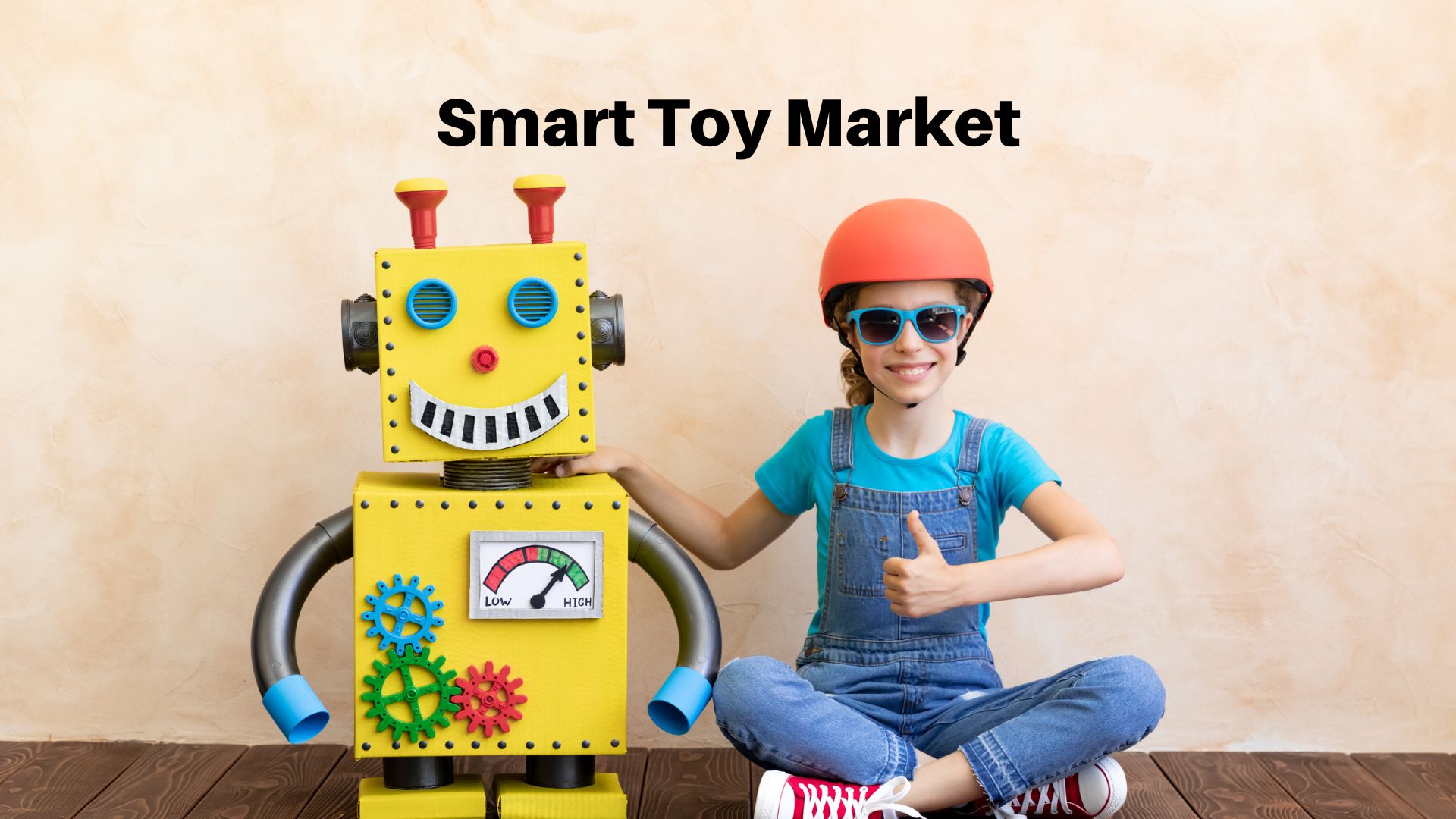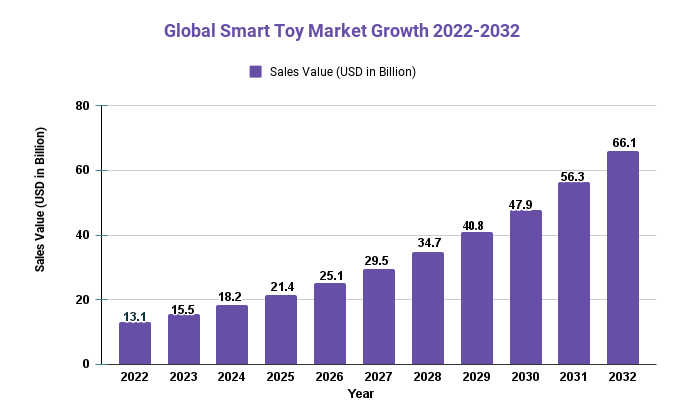Smart Toy Market Size to Reach USD 66.1 Billion by 2032 – Rise with Steller CAGR 17.50%

Page Contents
Market Overview
Published Via 11Press: The Global Smart Toy Market is projected to reach USD 66.1 Billion by 2032 from an expected value of USD 13.18 Billion in 2022, growing at an annual compounded compound growth rate of 17.50%.
The smart toy market has experienced remarkable growth over recent years due to advancements in technology and increasing consumer interest for interactive and educational toys.
The toy market can be divided into various segments based on product type, age group, and distribution channel. Examples of product types are interactive and robotic toys, educational toys, screenless toys and others, while age groups include toddlers, preschoolers and school-aged children. Distribution channels for toys can range from online retail stores such as WalMart or Best Buy to specialty shops or independent boutiques.
North America currently represents the highest adoption rates and presence of major market players for smart toys, while Europe and Asia-Pacific also exhibit rising adoption rates and an emphasis on educational toys.
Mattel Inc., Hasbro Inc., Sphero Inc., Anki Inc., WowWee Group Limited and Fisher-Price Inc are among the key market players in the smart toy industry. Each is actively engaging in product innovation, partnerships and acquisitions to gain a competitive edge within this highly contested space.
Overall, the smart toy market is predicted to experience steady expansion over the coming years due to rising consumer demand for interactive and educational toys as well as technological advancements.

Key Takeaways
- The Smart Toy Market size is projected to reach USD 63.5 Billion by 2032 from an initial valuation of USD 13.18 Billion in 2022, growing at an anticipated compound annual growth rate of 50% during the forecast period from 2023-2032.
- The market can be divided into various segments based on product type, age group and distribution channel. North America currently leads in terms of smart toy sales followed by Europe and Asia-Pacific.
- This market is driven by rising consumer demand for interactive and educational toys, along with advances in technology. Major market players have focused on product innovation, partnerships, and acquisitions as means to gain competitive advantages in this rapidly developing space.
Drivers, trends, and challenges have an impact on market dynamics, which can impact businesses. Request for PDF sample report
Regional Snapshot
- North America is currently the premier market for smart toys, driven by high adoption rates for such devices and the presence of leading market players in this region.
- Europe and Asia-Pacific are also significant markets, with increasing adoption rates and an emphasis on educational toys.
- Asia-Pacific region is expected to experience the highest compound annual growth rate over the forecast period due to rising disposable income levels, higher awareness about smart toys, and expanding distribution channels.
- Europe's toy market is projected to experience steady expansion due to increasing demand for screenless and educational toys.
- Latin America, Middle East, and Africa regions are anticipated to experience substantial expansion as more consumers adopt smart devices and become aware of their benefits.
Drivers
- Advancements in Technology: The smart toy market is being propelled forward by rapid advances in technology, including artificial intelligence (AI), augmented reality (AR) and internet of things (IoT) technologies being integrated into toys.
- Increasing demand for interactive and educational toys:Parents and educators increasingly recognize the value of interactive and educational toys in aiding children's development, driving an upsurge in demand for smart toys.
- Growing popularity of smart devices: As smartphones and tablets have become more widespread, so too has demand for toys compatible with these devices.
- Expanding distribution channels: With more consumers having access to smart toys through both online and offline retail channels, growth of this market has accelerated substantially.
- Focus on STEM Education: There has been an increased focus on science, technology, engineering and mathematics (STEM) education recently, driving an upsurge in demand for smart toys that help children develop skills in these areas.
Restraints
- High cost of smart toys: Consumers may find smart toys more expensive than their traditional counterparts, which may present barriers for some buyers. Concerns Over Security As more connected and data-driven toys become available on the market, concerns have grown about privacy and security – this could hinder its expansion further.
- Battery Life and Charging Requirements: Some smart toys require batteries or charging for play, which may be inconvenient for parents and limit children's play time.
- Limited Distribution in Certain Regions: Unfortunately, smart toys have yet to become widely available across certain markets which could hinder their potential growth potential in those regions.
- Competition from traditional toys: While demand for smart toys is on the rise, traditional toys still hold onto an overwhelming share of the market and may impede their expansion potential.
Opportunities
- An ever-increasing demand for screenless toys: With more people seeking out screenless toys that encourage physical activity and creativity, manufacturers of smart toy can now develop innovative and engaging products to satisfy this growing market need.
- Expansion into Emerging Markets: The smart toy market presents enormous growth potential in emerging markets such as Asia-Pacific, Latin America, and the Middle East, where there is an expanding middle class and growing adoption of smart devices.
- Partnerships with content creators: Smart toy manufacturers can form strategic alliances with authors of children's books, TV shows and movie studios in order to create toys that appeal to both children and parents.
- Personalization: Smart toy manufacturers can leverage data and AI technologies to offer tailored experiences for children, which may increase engagement and loyalty among purchasers.
- Integration with smart home devices: With more and more households adopting smart home devices, smart toy manufacturers have an opportunity to incorporate their products seamlessly with them for an immersive and enjoyable experience for children.
Challenges
- Data Privacy and Security Concerns: As smart toys become more connected and data-driven, concerns over privacy and security may limit consumer adoption and trust in these toys.
- Battery Life and Charging Needs: Many smart toys require batteries or charging, which can be inconvenient for parents and limit children's play time. High Development Costs: Producing smart toys involves extensive investments in technology and research which may pose barriers for smaller companies entering this space.
- Competiton from traditional toys: Although demand for smart toys is steadily increasing, traditional toys still account for a considerable share of the market, posing an ongoing challenge to smart toy manufacturers trying to distinguish themselves and increase market share.
- Compliance requirements: Smart toys must meet several compliance standards, such as those for safety and data protection, which can present manufacturers with an ongoing challenge of meeting and upholding.
Recent Developments
- In 2021, Mattel announced the launch of Hot Wheels ID, a new line of smart toys that allow children to race and track their Hot Wheels cars using an app.
- Hasbro launched the “Bring Home the Fun” campaign in 2020, which included the launch of several new smart toys, including the “Jedi Challenges” AR game and the “Power Rangers Beast Morphers Beast-X Ultrazord” toy.
- In 2020, Lego launched its “Super Mario” line of smart toys, which combines traditional Lego building with interactive features that allow children to play out real-life Super Mario games.
- In 2021, LeapFrog announced the launch of its new “LeapFrog Academy” platform, which provides children with interactive and educational games and activities.
- Spin Master, a leading smart toy manufacturer, announced the launch of several new products in 2021, including the “Hatchimals Pixies Crystal Flyers” and the “Air Hogs Stunt Shot.”
Key Market Segments
Based on Product Type
- Robots
- Interactive Games
- Educational Robots
Based on Distribution Channel
- Online
- Offline
Based on Technology
- Wi-Fi
- Bluetooth
- RFID or NFC
Based on End-User
- Toddlers
- Pre-schoolers
- School-going
- Stripling
- Other End-User
Market Key Players
- Playmobil
- Pillar Learning
- Sega Toys Co. Ltd.
- LeapFrog Enterprises Inc.
- Mattel Inc.
- Hasbro Inc.
- Lego System A/S
- Robofi LLC
- Tomy Co. Ltd.
- Doctor’s Associates Inc.
- Other Key Players
Report Scope
| Report Attribute | Details |
| The market size value in 2022 | USD 19.5 Bn |
| Revenue forecast by 2032 | USD 52.9 Bn |
| Growth Rate | CAGR Of 10.5% |
| Regions Covered | North America, Europe, Asia Pacific, Latin America, and Middle East & Africa, and Rest of the World |
| Historical Years | 2017-2022 |
| Base Year | 2022 |
| Estimated Year | 2023 |
| Short-Term Projection Year | 2028 |
| Long-Term Projected Year | 2032 |
FAQs
Q: What is a smart toy?
A: A smart toy is a toy that is connected to the internet or a mobile device, allowing it to interact with children in new and engaging ways. Smart toys often include features such as sensors, cameras, and microphones that enable them to respond to voice commands and gestures.
Q: What are the benefits of smart toys?
A: Smart toys can provide several benefits, including promoting learning and development, enhancing creativity and imagination, and improving social skills through interactive play. They can also provide children with a unique and engaging play experience that traditional toys cannot.
Q: Are smart toys safe for children?
A: Like all toys, smart toys should be designed and manufactured with safety in mind. It is important for parents to research the safety features and data privacy policies of any smart toy before purchasing it for their child.
Q: What age group are smart toys suitable for?
A: Smart toys are available for children of all ages, from infants to teenagers. Many smart toys are designed specifically for certain age groups, so it is important to choose a toy that is appropriate for a child's developmental stage.
Q: What is the future of the smart toy market?
A: The smart toy market is expected to continue to grow in the coming years, driven by advancements in technology, increasing demand for interactive and educational toys, and expansion into emerging markets. Smart toy manufacturers will need to continue to innovate and differentiate themselves to stay competitive in the market.
The team behind market.us, marketresearch.biz, market.biz and more. Our purpose is to keep our customers ahead of the game with regard to the markets. They may fluctuate up or down, but we will help you to stay ahead of the curve in these market fluctuations. Our consistent growth and ability to deliver in-depth analyses and market insight has engaged genuine market players. They have faith in us to offer the data and information they require to make balanced and decisive marketing decisions.



